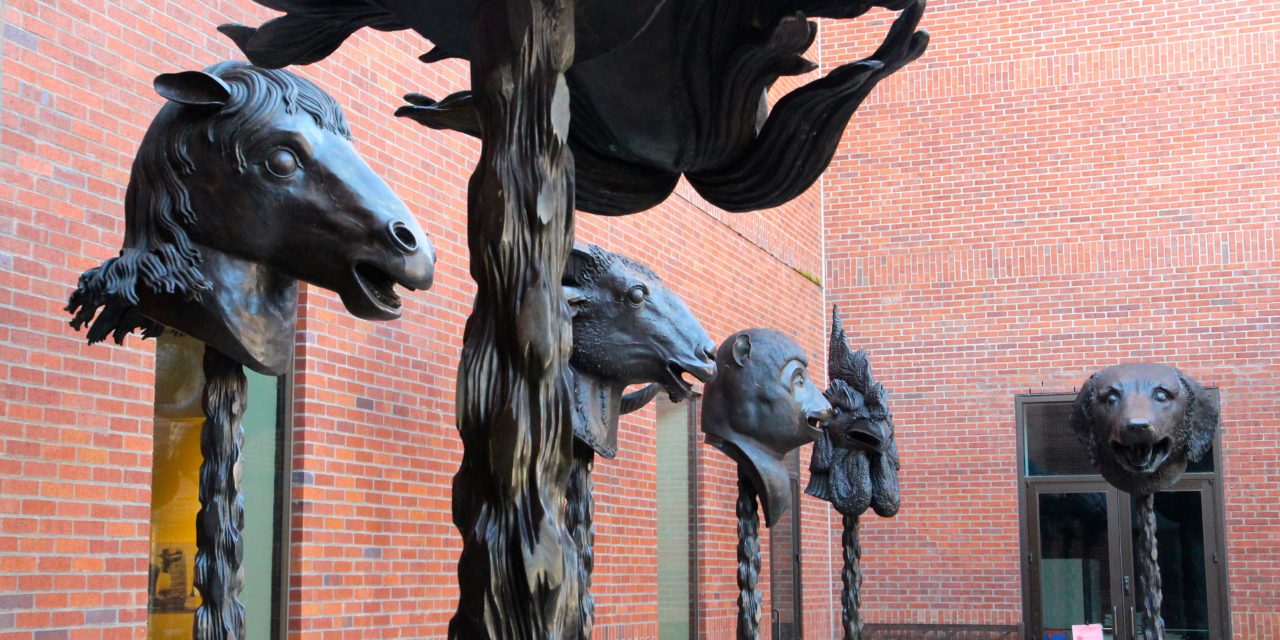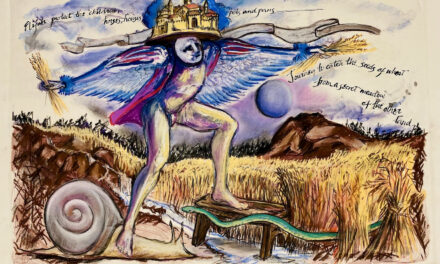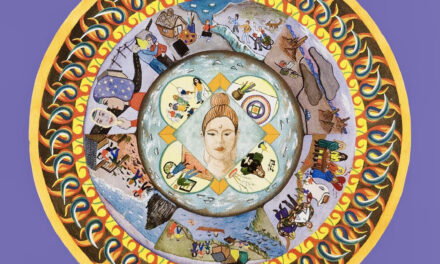(Above: Renowned Chinese artist Ai Weiwei’s massive “Circle of Animals/Zodiac Heads” is on view in an outside courtyard at the Jordan Schnitzer Museum of Art on the University of Oregon campus.)
By Randi Bjornstad
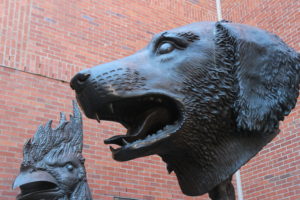
Ai Weiwei’s rooster and dog are part of his zodiac creatures sculpture exhibit. This year is Year of the Rooster; the Year of the Dog follows in 2018
They’re huge, gorgeous and mightily impressive, and the dozen animals of the Chinese Zodiac — not to be confused with the Western astrological signs — as rendered by world-renowned Chinese artist Ai Weiwei, are on display at the Jordan Schnitzer Museum of Art at the University of Oregon through the summer solstice in June.
The pieces are available through the museum’s “master works on loan” program, which brings art from private collections into public view, in some cases in return for a tax advantage.
“These sculptures have been shown a lot and have been seen by millions of people since 2011, but they were recently acquired by a private collector, so they might not be available for viewing any more, at least not widely,” museum communications manager Debbie Williamson Smith said.
Because of the size and weight — the massive zodiac heads are bronze and sit on 10-foot-high pedestals — installation of the exhibit was lengthy and complicated, Williamson Smith said.
“Because they are so huge and heavy, we had to install concrete (pads) to hold them,” she said. “We did a concrete pour, and that had to cure for a month, and then we had to bring in a crane to lift the sculptures up and over a high wrought-iron fence to install them.”
All this happened during November’s less-than-wonderful weather, Williamson Smith recalled. “It took three days to do, and one day was horrifically rainy, and the rest were really cold.”
Ai, a 60-year-old artist and political activist — his father was a poet and he and his entire family spent three years in a Chinese labor camp starting when Ai was just 1 year old — created two series of zodiac heads, one bronze and a much smaller series in bronze with a gold overlay, she said. The Portland Art Museum exhibited the gold series two years ago.
The Chinese zodiac, or Sheng Xiao, includes 11 real animals — rat, ox, tiger, rabbit, snake, horse, sheep, monkey, rooster, dog and pig — as well as the mythical dragon. Each animal “rules” for a year of the 12-year cycle, which is calculated on the Chinese lunar calendar. The dragon falls between the rabbit and the snake.
2017 has been the Year of the Rooster, so 2018 will be Year of the Dog. The dragon is considered by many in China to be the most important and propitious symbol, so many couples try to time pregnancies to occur during the Year of the Dragon, which will occur again in 2024.
Ai’s zodiac grouping is a reinterpretation of the 12 animal heads that once adorned a fountain clock at the Old Summer Palace, known as Yuanming Yuan, an imperial retreat not far from Beijing.
The original pieces were designed in the 18th century by two Jesuit monks who were residents of the imperial court during the Qing Dynasty which lasted from 1644 to 1911. But in 1860, French and British troops ransacked the palace during the Second Opium War, and the small sculpted heads were part of the plunder.
Since then, several have been recovered and are in a museum in Beijing, but others are still unaccounted for, probably held in private collections.
Private collectors share their treasures
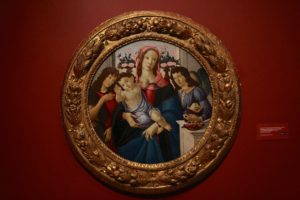
Sandro Botticelli’s painting of the Madonna and Child with St. Peter is one of the masterworks on loan at the Jordan Schnitzer Museum of Art
A few days ago, Williamson Smith happily walked through several indoor galleries in the Schnitzer museum, pointing out other artwork also on exhibit, also thanks to the largesse of private owners.
One, an exquisite painting by Sandro Botticelli titled “The Madonna and Child with Saint John the Baptist and an Angel Before a Window,” would be right at home in an art museum in Rome or Florence, Italy. The tempera-on-panel piece dates to the late 1400s and comes from the Loren Schlachet Collection. Botticelli, whose full name was Alessandro di Mariano Filipepi, lived from 1445 to 1510.
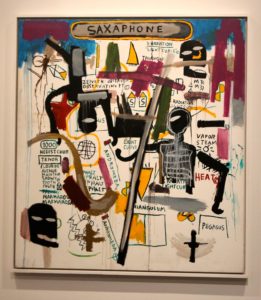
Jean-Michel Basquiat’s “Saxaphone” is on loan to the Schnitzer art museum
One of early modernist painter Marc Chagall’s many renditions of flowers and lovers also is on the walls at the Schnitzer museum. So is a painting titled “Saxaphone” by New York neo-expressionist street artist Jean-Michel Basquiat, an artist of Haitian heritage who was born and grew up in Brooklyn and died of a heroin overdose in 1988, four months short of his 28th birthday.
Students also are artistic
For a change of pace, but not of obvious talent, the art museum also has its annual “Art of the Athlete” on display, featuring work by University of Oregon student athletes.
“I think this may be the most wonderful ‘Art of the Athlete’ show we have seen yet,” Williamson Smith said. “Some of

UO football player Fotu Leiato II, a junior psychology major, created a self-portrait for the Art of the Athlete exhibit
our artists have been participating for several years now,
and they are showing some really great talent.”
Many this year tackled portraits, and one group of for football players collaborated on their own splatter picture, reminiscent of Jackson Pollock’s fractal paintings.
The student-athlete art show ends Feb. 4.
Jordan Schnitzer Museum of Art
Where: 1430 Johnson Lane, University of Oregon campus
Museum hours: 11 a.m. to 8 p.m. Wednesday, 11 a.m. to 5 p.m. Thursday through Sunday
Information: 541-346-3027 or jsma.uoregon.edu
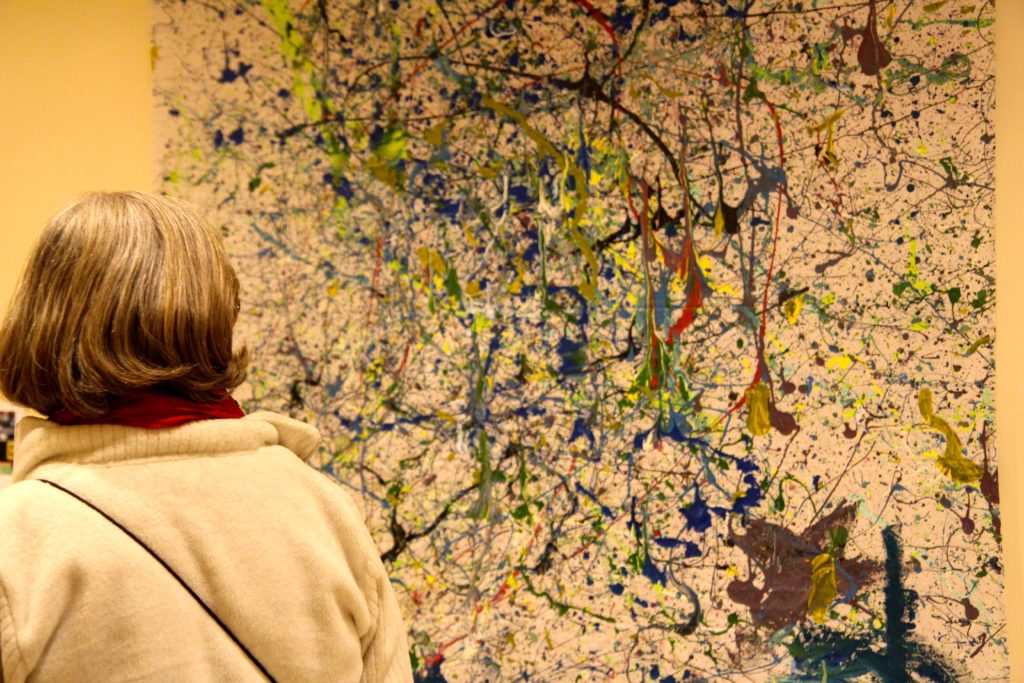
A recent visitor to the Jordan Schnitzer Museum of Art peruses “Systematic Chaos,” created by UO football players Tyrell Crosby, Royce Freeman, Jalen Jelks and Jacob Capra, using acrylic paint, house paint and a canvas dropcloth

